| Scheme | Colour name | FS number | BS number | Humbrol | XtraColor | Vallejo Model Color | Vallejo Model Air | Hataka | |
|---|---|---|---|---|---|---|---|---|---|
| Boeing (Consolidated) PB2B-1 Catalina IVB | |||||||||
| RAF Standard #1 | Upper surfaces | Extra Dark Sea Grey | ~6099 | BS:640 | 123 / 106 | X005 / X376 | 70.866 | 71.110 | ~140 |
| Undersides | White | ~7875 | 34 | 70.951 | 71.001 | ~043 | |||
| Boeing (Consolidated) PB2B-2 Catalina VI | |||||||||
| Standard #1 | Overall | Aluminium dope | 56 / 191 | 70.864 | 71.062 | - | |||
| Consolidated PBY-5 Catalina: P-200 till P-206 (after overhaul) | |||||||||
| Standard #2 | Overall | Aluminium dope | 56 / 191 | 70.864 | 71.062 | - | |||
| Y-86 & Y-87 (later P-86 & P-87): Temperate Sea scheme, wing span larger than 75 feet | |||||||||
| Standard #1 | Upper surfaces | Dark Slate Grey | 102 | X025 | 70.892 | 71.092 | ~202 | ||
| Extra Dark Sea Grey | ~6099 | BS:640 | 123 / 106 | X005 / X376 | 70.866 | 71.110 | ~140 | ||
| Undersides | Sky | - | BS:210 | 90 | X004 / X130 | - | 71.302 | ~026 | |
| Consolidated PBY-5 Catalina: Y-38 t/m Y-73; Delivery scheme, initally orange triangles; but from february 1942 and on with flags as national insigna. |
|||||||||
| Standard #1 | Upper surfaces | Dark Sea Blue Grey: ANA 623 ?? | 35042 | 181 | X121 | 70.990 | ~001 | ||
| Undersides | Milky White | 90 (mixed with white) | X007 (mixed with white) | 70.885 | 71.103 (mixed with white) | - | |||
| Consolidated PBY-5A Catalina: Y-74 t/m Y-85, later P-75 t/m P-85 | |||||||||
| Standard #1 | Upper surfaces | Dark Sea Blue Grey: ANA 623 ?? | 35042 | 181 | X121 | 70.990 | ~001 | ||
| Undersides | Milky White | 90 (mixed with white) | X007 (mixed with white) | 70.885 | 71.103 (mixed with white) | - | |||
| Consolidated PBY-5A Catalina: P-211 t/m P-225 (after overhaul) | |||||||||
| Standard #2 | Overall | Aluminium dope | 56 / 191 | 70.864 | 70.062 | - | |||
Several colour scheme's applied on the PBY-5 Catalina.
These scheme's are meant for illustration purposes only. The size and type of used fonts of the serials, the size of the roundels etcetera might not be correct, but are as good as possible a simulation of the original.
Further there are many differences between individual aircraft regarding antennas, exhaust and also markings like squadron markings.
Many aircraft had black anti-fouling applied on the undersides of the fuselage.
Just in case you want to built a Dutch Catalina, check you references very well!

Rudder painted in camouflage colours, no Dutch markings on the upper sides of the wing.

Identical to paint scheme 2. The markings on the fuselage are resized to 1/3 of the original size.
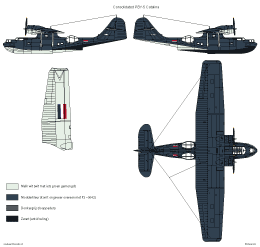
Identical to paint scheme 3, with Dutch flags as nationality markings.
Left side view : The rear part of the underside of the fuselage of Y-57 is panted with a dark (black?) colour .
Right side: Under side of the fuselage of P-200 had black anti-fouling applied.
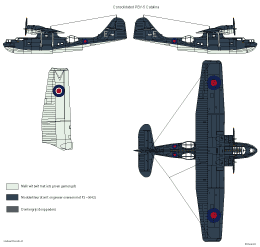
Identical to paint scheme 3, with English RAF markings. These were applied during ferry flights.

De Y-69 is one of the few Dutch "Black Cat's", these were painted overall black because of nightly operations.
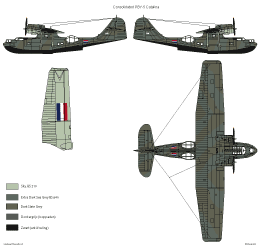
Applied on Y-86 and Y-87. Identical to the RAF paint scheme (for aircraft with a wingspan larger than 75 feet). This drawing is partly reconstructed with the help of photo's of the Y-87.
Several colour scheme's applied on the PB2B-1 Catalina IV.

This particular aircraft still had the paint scheme of the RAF, the first owner, applied.

Overall aluminium-dope with Dutch flags.
Undersides of the fuselage had black anti-fouling applied.
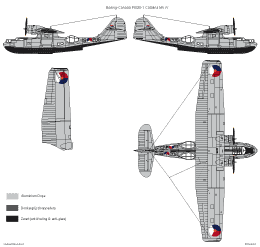
Overall aluminium-dope with Dutch roundels and new serials.
Undersides of the fuselage had black anti-fouling applied.
Colour scheme applied on the PB2B-2 Catalina VI.
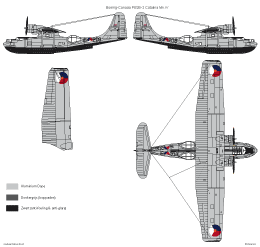
Overall aluminium-dope with Dutch flags.
Undersides of the fuselage had black anti-fouling applied.
Several colour scheme's applied on the PBY-5A Catalina.
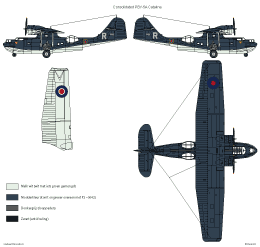
Identical to scheme 1, with English RAF markings. These were applied during ferry flights, mentioned in the test above.
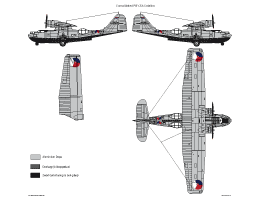
Undersides of the fuselage had black anti-fouling applied.
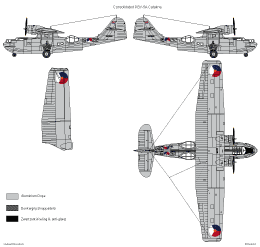
Note the changed position of several markings.
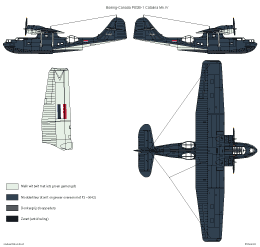

 Nederlands (nl-NL)
Nederlands (nl-NL)  English (United Kingdom)
English (United Kingdom)